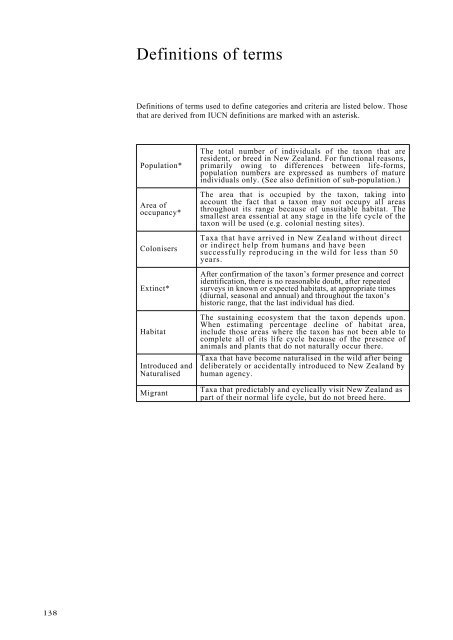PDF, 332K - Department of Conservation
PDF, 332K - Department of Conservation
PDF, 332K - Department of Conservation
You also want an ePaper? Increase the reach of your titles
YUMPU automatically turns print PDFs into web optimized ePapers that Google loves.
138<br />
Definitions <strong>of</strong> terms<br />
Definitions <strong>of</strong> terms used to define categories and criteria are listed below. Those<br />
that are derived from IUCN definitions are marked with an asterisk.<br />
Population*<br />
Area <strong>of</strong><br />
occupancy*<br />
Colonisers<br />
Extinct*<br />
Habitat<br />
Introduced and<br />
Naturalised<br />
Migrant<br />
The total number <strong>of</strong> individuals <strong>of</strong> the taxon that are<br />
resident, or breed in New Zealand. For functional reasons,<br />
primarily owing to differences between life-forms,<br />
population numbers are expressed as numbers <strong>of</strong> mature<br />
individuals only. (See also definition <strong>of</strong> sub-population.)<br />
The area that is occupied by the taxon, taking into<br />
account the fact that a taxon may not occupy all areas<br />
throughout its range because <strong>of</strong> unsuitable habitat. The<br />
smallest area essential at any stage in the life cycle <strong>of</strong> the<br />
taxon will be used (e.g. colonial nesting sites).<br />
Taxa that have arrived in New Zealand without direct<br />
or indirect help from humans and have been<br />
successfully reproducing in the wild for less than 50<br />
years.<br />
After confirmation <strong>of</strong> the taxon’s former presence and correct<br />
identification, there is no reasonable doubt, after repeated<br />
surveys in known or expected habitats, at appropriate times<br />
(diurnal, seasonal and annual) and throughout the taxon’s<br />
historic range, that the last individual has died.<br />
The sustaining ecosystem that the taxon depends upon.<br />
When estimating percentage decline <strong>of</strong> habitat area,<br />
include those areas where the taxon has not been able to<br />
complete all <strong>of</strong> its life cycle because <strong>of</strong> the presence <strong>of</strong><br />
animals and plants that do not naturally occur there.<br />
Taxa that have become naturalised in the wild after being<br />
deliberately or accidentally introduced to New Zealand by<br />
human agency.<br />
Taxa that predictably and cyclically visit New Zealand as<br />
part <strong>of</strong> their normal life cycle, but do not breed here.

















